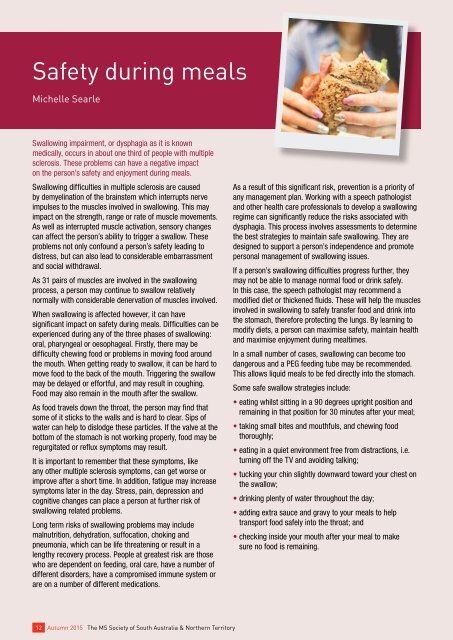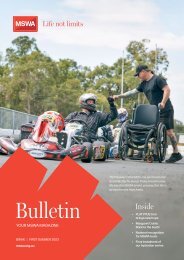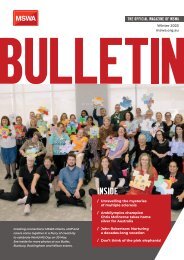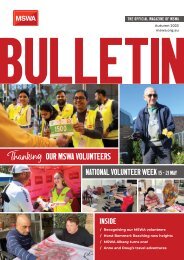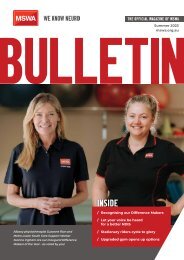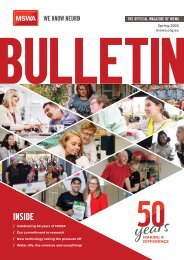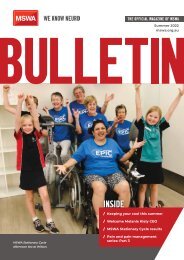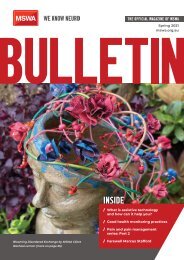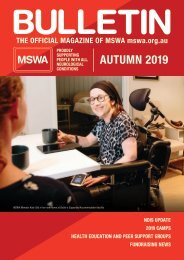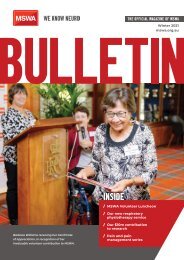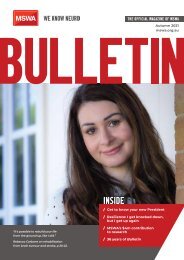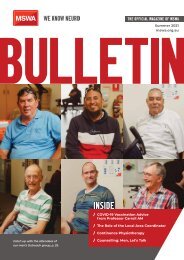MSSANT Network Autumn 15 WEB
Create successful ePaper yourself
Turn your PDF publications into a flip-book with our unique Google optimized e-Paper software.
Safety during meals<br />
Michelle Searle<br />
Swallowing impairment, or dysphagia as it is known<br />
medically, occurs in about one third of people with multiple<br />
sclerosis. These problems can have a negative impact<br />
on the person’s safety and enjoyment during meals.<br />
Swallowing difficulties in multiple sclerosis are caused<br />
by demyelination of the brainstem which interrupts nerve<br />
impulses to the muscles involved in swallowing. This may<br />
impact on the strength, range or rate of muscle movements.<br />
As well as interrupted muscle activation, sensory changes<br />
can affect the person’s ability to trigger a swallow. These<br />
problems not only confound a person’s safety leading to<br />
distress, but can also lead to considerable embarrassment<br />
and social withdrawal.<br />
As 31 pairs of muscles are involved in the swallowing<br />
process, a person may continue to swallow relatively<br />
normally with considerable denervation of muscles involved.<br />
When swallowing is affected however, it can have<br />
significant impact on safety during meals. Difficulties can be<br />
experienced during any of the three phases of swallowing:<br />
oral, pharyngeal or oesophageal. Firstly, there may be<br />
difficulty chewing food or problems in moving food around<br />
the mouth. When getting ready to swallow, it can be hard to<br />
move food to the back of the mouth. Triggering the swallow<br />
may be delayed or effortful, and may result in coughing.<br />
Food may also remain in the mouth after the swallow.<br />
As food travels down the throat, the person may find that<br />
some of it sticks to the walls and is hard to clear. Sips of<br />
water can help to dislodge these particles. If the valve at the<br />
bottom of the stomach is not working properly, food may be<br />
regurgitated or reflux symptoms may result.<br />
It is important to remember that these symptoms, like<br />
any other multiple sclerosis symptoms, can get worse or<br />
improve after a short time. In addition, fatigue may increase<br />
symptoms later in the day. Stress, pain, depression and<br />
cognitive changes can place a person at further risk of<br />
swallowing related problems.<br />
Long term risks of swallowing problems may include<br />
malnutrition, dehydration, suffocation, choking and<br />
pneumonia, which can be life threatening or result in a<br />
lengthy recovery process. People at greatest risk are those<br />
who are dependent on feeding, oral care, have a number of<br />
different disorders, have a compromised immune system or<br />
are on a number of different medications.<br />
As a result of this significant risk, prevention is a priority of<br />
any management plan. Working with a speech pathologist<br />
and other health care professionals to develop a swallowing<br />
regime can significantly reduce the risks associated with<br />
dysphagia. This process involves assessments to determine<br />
the best strategies to maintain safe swallowing. They are<br />
designed to support a person’s independence and promote<br />
personal management of swallowing issues.<br />
If a person’s swallowing difficulties progress further, they<br />
may not be able to manage normal food or drink safely.<br />
In this case, the speech pathologist may recommend a<br />
modified diet or thickened fluids. These will help the muscles<br />
involved in swallowing to safely transfer food and drink into<br />
the stomach, therefore protecting the lungs. By learning to<br />
modify diets, a person can maximise safety, maintain health<br />
and maximise enjoyment during mealtimes.<br />
In a small number of cases, swallowing can become too<br />
dangerous and a PEG feeding tube may be recommended.<br />
This allows liquid meals to be fed directly into the stomach.<br />
Some safe swallow strategies include:<br />
• eating whilst sitting in a 90 degrees upright position and<br />
remaining in that position for 30 minutes after your meal;<br />
• taking small bites and mouthfuls, and chewing food<br />
thoroughly;<br />
• eating in a quiet environment free from distractions, i.e.<br />
turning off the TV and avoiding talking;<br />
• tucking your chin slightly downward toward your chest on<br />
the swallow;<br />
• drinking plenty of water throughout the day;<br />
• adding extra sauce and gravy to your meals to help<br />
transport food safely into the throat; and<br />
• checking inside your mouth after your meal to make<br />
sure no food is remaining.<br />
12<br />
<strong>Autumn</strong> 20<strong>15</strong> The MS Society of South Australia & Northern Territory


